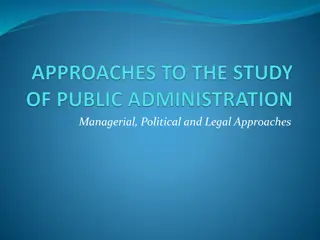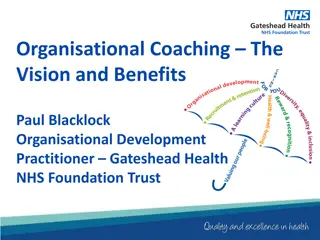Enhancing Managerial Skills Through Coaching Techniques
Gain an understanding of coaching for managers, its benefits in leadership development, and the differences between coaching, mentoring, and counseling. Explore the features of coaching, essential skills such as building rapport and asking effective questions, and the GROW model of coaching. Unleash potential, raise awareness, and improve performance with proven coaching practices.
Download Presentation

Please find below an Image/Link to download the presentation.
The content on the website is provided AS IS for your information and personal use only. It may not be sold, licensed, or shared on other websites without obtaining consent from the author.If you encounter any issues during the download, it is possible that the publisher has removed the file from their server.
You are allowed to download the files provided on this website for personal or commercial use, subject to the condition that they are used lawfully. All files are the property of their respective owners.
The content on the website is provided AS IS for your information and personal use only. It may not be sold, licensed, or shared on other websites without obtaining consent from the author.
E N D
Presentation Transcript
Aim of the presentation To gain an understanding of coaching and how it applies to leadership.
Why Coach? Coaching is a personal development tool which can enhance individual and organisational effectiveness. It is the fastest growing facet of leadership development today. My Trust has made a commitment to develop a coaching culture throughout the organisation by introducing a number of learning strands: coaching practitioner training and accreditation; coaching for leadership and peer coaching; and coaching skills for managers.
Defining Coaching and Mentoring Clear definitions of coaching and mentoring have been agreed to ensure a shared understanding for all participants in coaching / mentoring activity. Coaching Coaching is a questioning and supportive process in which the Coach supports and facilitates improvements to another s performance. This may be through discussion and planning for achievement of goals and actions towards increased competence, commitment and confidence. The coaching questioning process usually involves growth and change, whether that is in skills, knowledge, attitude or behaviour. Mentoring A process in which the mentor serves as an experienced role model, or trusted advisor, to guide or support another in their development. They may pass on knowledge and experience; provide opportunities for development and growth or open doors to opportunities.
Features of Coaching Is learner centered Is self-discovery Unlocks potential Raises awareness Encourages responsibility Raises performance
Activity Do you know the difference? Coaching Training Mentorin g Counselli ng
To summarise Counselling Coaching Mentoring PAST FUTURE
Coaching is unlocking peoples potential to maximise their own performance Timothy Gallwey (1975) The inner game of tennis
Fundamental Coaching Skills Building rapport (Starr 2008) or relationships Different levels Giving feedback of listening and support Coaching Skills Asking Using (Starr 2008) Questions Intuition
GROW model of coaching John Whitmore s MAP of COACHING Key principles Raise awareness; take responsibility (coachee) Skills Effective questioning; active listening (coach) Steps G - GOAL What do you want? R - REALITY What is happening now? O - OPTIONS What could you do? W - WILL What will you do?
GROW model of coaching Goal What do you want? Will what will you do to make a change? Reality what is happening now? Options what could you do to make a change?
Contracting, rapport building, identifying topic or discussion areas. Topic (Entry) This is the end point where the client wants to be. It should be defined in such a way that it is clear when the goal has been achieved. GOAL How far away from the goal is the client? Looking at all the steps needed to achieve the goal; how many steps has the client taken already? How far along the line are they? REALITY There will be obstacles to the client achieving their goal. What are the different things the client can do in order to overcome the obstacles and reach the goal? OPTIONS Turn the options into action points this is a commitment to take action. Define a time frame. This is the way forward WILL
GROW discussion GOAL -Coach and coachee agree on a specific aim objective and topic for discussion REALITY Both coach and coachee invite self-assessment and offer specific examples to illustrate their points OPTIONS Coach gets suggestions from the coachee by asking effective questions and guides them towards making the right choices WILL Coach and coachee commit to action, define a time frame for objectives and identify how to overcome obstacles
Goal setting Goals are our targets or what we intend to achieve, and research indicates that those with clearly thought out goals achieve much more than those without goals. Your clients will have a variety of goals, with a variety of reasons for wanting to achieve those goals. It s your job to help them clarify exactly what their goal is, and how they intend to achieve it!
What do you want to change? A basic premise of coaching is that we want something to be different. Our role as coach is to help the performer to get a full understanding of this gap and to make sure that they have a compelling vision of the future that they want. Would you tell me which way I ought to go from here? asked Alice That depends a good deal on where you want to get to. said the cat I don t much care where. said Alice Then it doesn t matter which way you go. replied the cat Lewis Carroll Alice s Adventures in Wonderland
Research One of the most powerful pieces of research was completed on Yale University graduates in America. They were surveyed in 1950's and again 20 years later. The research showed that 3% were worth more than the other 97% put together. The 3% also had better health and enjoyed better relationships with others. What explained this 3% 97% split was not parental wealth, degree subjects taken, career selected, ethnic or gender base etc. The difference was that the 3% had written goals in the 1950's while the huge majority did not.
Write it down! There are lots of different tools that can be used to keep a written record of your clients goal; SMART Well formed outcomes Establishing your life purpose Multiple pathways
Activity Goal setting Choose one of the tools, and write down one of your own goals
Building Rapport / Using Intuition What creates rapport? Physical appearance / clothes Body language / physical gestures Quality of voice Language / words used Beliefs and values What is intuition? skills to shape and guide a coaching conversation (Starr 2003)
Entry - Initiating and Building Relationships How do you build rapport? Work in pairs have a chat! Complete a getting to know you exercise for example ask about: Employment history Hobbies Personal Achievements Remember the coach should: Only ask questions (don t share!) Reflect back (and make links)
Influencing Style Pull Helping them solving the problem Listening Reflecting Paraphrasing Summarising Asking questions Giving feedback Making suggestions Offering guidance Giving advice Instructing Telling Solving the problem for them Push
Understanding your client If a coach wants to understand an individual, it s important that they have an understanding of their drivers and motivation. Think about one of your members of staff - What issues do they face? What are their drivers or motivators? What is their role or function? What is their view of the world ?
Questioning Who? What? When? How much? How many? What else? Avoid - Why? and How?
Questioning some examples What else? (then silence) If you knew the answer, what would it be? What would the consequences of that be for you or for others? What is the hardest/ most challenging part of this for you? What advice would you give to a friend in your position? Imagine talking to the wisest person you know what would they say? What would you gain/ lose by doing that? John Whitmore, Coaching for Performance, 1992
Levels of Listening Cosmetic listening Conversational listening Active listening Deep listening (Starr 2008)
Levels of Listening If it looks like I m listening, I m not really I m somewhere else Cosmetic listening I m engaged in the conversation; listening, talking, thinking etc. Conversational listening I m very focussed on what you re saying; recording facts, paying attention Active listening I m more focussed on you than me; I m getting a sense of who you are now Deep listening (Starr 2008)
Practical Coaching Exercise Groups of 3: 1 coach, 1 coachee, 1 observer 10 minutes per coaching interview 5 minutes for feedback and observer review (Total: 15 minutes per session) Using the GROW Questions, conduct a 1:1 coaching session with another delegate. Coachee should briefly outline a real or potential situation that they want to change Coaches to conduct a coaching session using GROW to achieve a simple coaching action plan Observers to feedback
Learning and Actions Key learning points Actions / changes to personal practice























